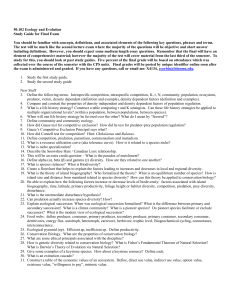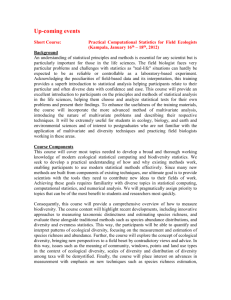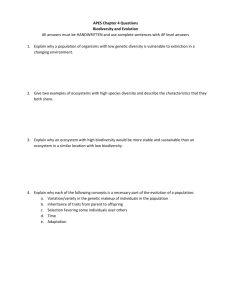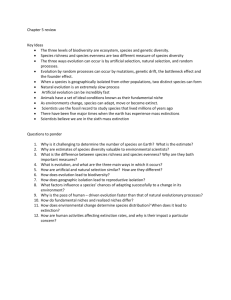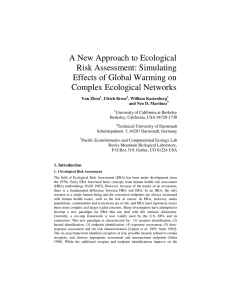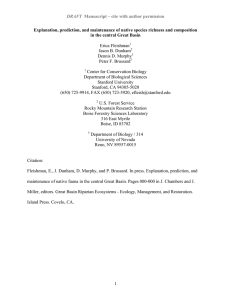Practice Worksheet Lecture 6 : Ecological communities and
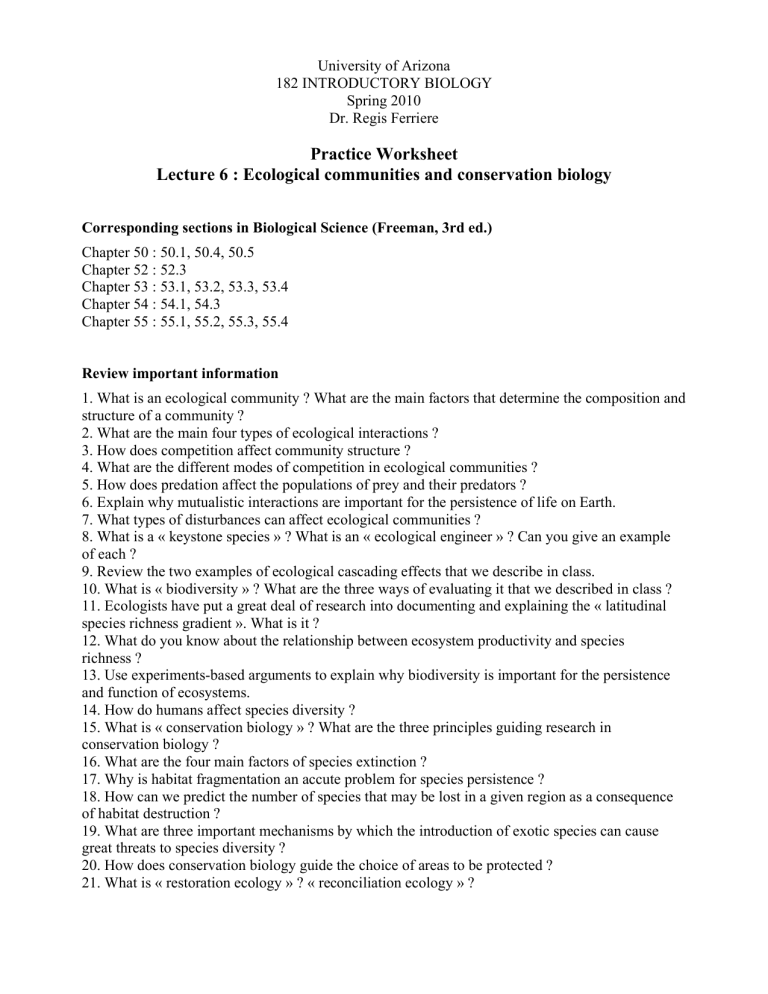
University of Arizona
182 INTRODUCTORY BIOLOGY
Spring 2010
Dr. Regis Ferriere
Practice Worksheet
Lecture 6 : Ecological communities and conservation biology
Corresponding sections in Biological Science (Freeman, 3rd ed.)
Chapter 50 : 50.1, 50.4, 50.5
Chapter 52 : 52.3
Chapter 53 : 53.1, 53.2, 53.3, 53.4
Chapter 54 : 54.1, 54.3
Chapter 55 : 55.1, 55.2, 55.3, 55.4
Review important information
1. What is an ecological community ? What are the main factors that determine the composition and structure of a community ?
2. What are the main four types of ecological interactions ?
3. How does competition affect community structure ?
4. What are the different modes of competition in ecological communities ?
5. How does predation affect the populations of prey and their predators ?
6. Explain why mutualistic interactions are important for the persistence of life on Earth.
7. What types of disturbances can affect ecological communities ?
8. What is a « keystone species » ? What is an « ecological engineer » ? Can you give an example of each ?
9. Review the two examples of ecological cascading effects that we describe in class.
10. What is « biodiversity » ? What are the three ways of evaluating it that we described in class ?
11. Ecologists have put a great deal of research into documenting and explaining the « latitudinal species richness gradient ». What is it ?
12. What do you know about the relationship between ecosystem productivity and species richness ?
13. Use experiments-based arguments to explain why biodiversity is important for the persistence and function of ecosystems.
14. How do humans affect species diversity ?
15. What is « conservation biology » ? What are the three principles guiding research in conservation biology ?
16. What are the four main factors of species extinction ?
17. Why is habitat fragmentation an accute problem for species persistence ?
18. How can we predict the number of species that may be lost in a given region as a consequence of habitat destruction ?
19. What are three important mechanisms by which the introduction of exotic species can cause great threats to species diversity ?
20. How does conservation biology guide the choice of areas to be protected ?
21. What is « restoration ecology » ? « reconciliation ecology » ?
Test your knowledge
Q1. Competition can take place _____ species. Between-species competition can result in _____, that is, the extinction of the population of an _____ competitor. Predation can cause _____. _____, such as plant-pollinator interaction, enhances population growth of each partner species.
A. competitive exclusion
B. mutualism
C. population cycles
D. within or between
E. inferior
Q2.
A _____ affects the entire community (composition and structure) out of proportion to its own abundance. An _____ is a species that creates environments for other species. For example, _____ cut down trees selectively, build dams and thus create meadows and ponds that become _____ for
_____.
A. other species
B. habitats
C. ecosystem engineer
D. beavers
E. keystone species
Q3. _____ can be measured by (1) _____, that is, the census of all genes and alleles present in all individuals of all species of an ecological community; or by (2) _____, that is, the total number and relative abundance of species in a community; or by (3) _____, that is, the number and types of ecological interactions and species functions in an ecological network. Species richness tends to
_____ as latitude _____ (toward the equator). In general, _____ results in greater species richness, and conversely, higher richness of plant species _____ primary productivity.
A. increase
B. increases
C. decreases
D. ecosystem and functional diversity
E. biodiversity
F. species richness
G. higher ecosystem productivity
H. genetic diversity
Q4. _____ is the major factor of the current extinction crisis. Other significant factors of species extinction include: ______, _____ species, and _____ in the environment such as pollution and
_____. As _____ become more fragmented, the communities they support become disproportionately more exposed to _____ that _____ the risk of species extinction.
A. global changes
B. habitats
C. introduced
D. habitat loss
E. increase
F. edge effects
G. climate warming
H. overexploitation
Q5. Invasive species _____ competition. For example, purple loosestrife is crowding out _____ organisms in North American marshes. Invasive species also introduce _____. For example, an introduced _____ has virtually wiped out the American chestnut. Introduced species may also increase _____. For example, the brown tree snake has _____ dozens of bird species on Guam.
A. native
B. extinguished
C. disease
D. predation
E. increase
F. fungus
Q6. To preserve biodiversity it is essential to establish _____. Areas to protect can be chosen by identifying _____ of biodiversity, based on _____, number of _____ (that is, species that have very small geographic ranges), and _____.
A. hotspots
B. level of threat
C. protected areas
D. endemic species
E. species richness
